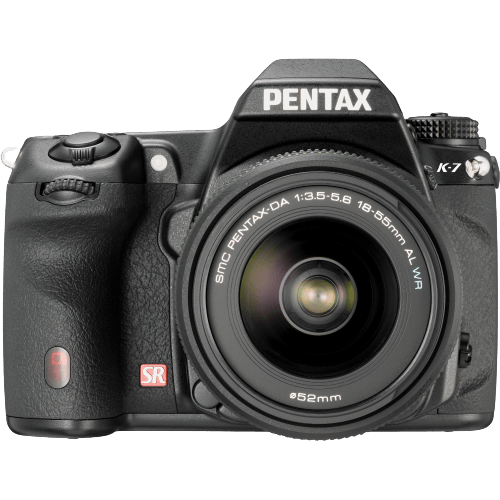Pentax K7 Specs and Scores

The Pentax K7 scores a 52/100 in our evaluation. Announced on May 20th, 2009, this DSLR camera was initially priced at $1900. With dimensions of 131 x 97 x 73mm and weighing 750g (1.65lbs), it is a compact and portable option. However, considering that it was released in 2009, its specifications may not be as competitive in today’s market. While still a decent camera, newer models have surpassed the Pentax K7 in terms of features and performance.
Pentax K7 Overview and Optics
The Pentax K7 receives an optics score of 51/100. This camera boasts a 14.6-megapixel resolution, a shooting speed of 5.2 frames per second, and a CMOS sensor. The Prime II processor contributes to its performance, and the sensor earns a DXOMARK score of 61. The sensor size is APS-C, and the camera uses a Pentax KAF lens mount. Additionally, the K7 includes image stabilization and has an aspect ratio of 3:2.
Comparing these specifications to today’s market, the Pentax K7 falls behind in terms of megapixels and shooting speed. Modern cameras generally offer higher resolutions and faster shooting speeds. However, the K7’s image stabilization and the Prime II processor are still competitive features.
The Pentax K7’s optics score of 51/100 reveals that it is not a leading option in today’s market. While some features remain competitive, others lag behind newer models. The K7 may be suitable for photographers who prioritize image stabilization and processor performance over resolution and shooting speed.
Pentax K7 Video Performance
The Pentax K7 scores 49/100 in the video category. Its maximum video resolution is standard HD, with dimensions of 1536 x 1024 pixels. Moreover, the camera captures videos at a frame rate of 30 frames per second. The K7 also includes a built-in time-lapse functionality.
In today’s market, the Pentax K7’s video capabilities seem outdated. Many modern cameras offer higher resolutions, such as 4K and even 8K, and faster frame rates for smoother video playback. Additionally, features like image stabilization and autofocus tracking have become standard in current camera models.
Despite its lower score, the Pentax K7 still provides basic video recording options and time-lapse functionality. However, it falls short when compared to the advanced video capabilities available in today’s competitive camera market.
Pentax K7 Features and Benefits
The Pentax K7 features a score of 54/100 in terms of its specifications. The camera has a 3-inch screen with a resolution of 921,000 dots, but lacks modern features such as a touchscreen, flip screen, GPS, WIFI, and Bluetooth.
Considering the current market, the Pentax K7’s specifications fall short when compared to more recent camera models. The absence of a touchscreen and flip screen limits its ease of use and versatility, while the lack of GPS, WIFI, and Bluetooth hinders its connectivity capabilities.
The Pentax K7 has decent features for its time, but it struggles to compete with the advanced technology found in today’s cameras. It is essential to consider these specifications when deciding on a camera to ensure it meets the required standards and functionality.
Pentax K7 Storage and Battery
The Pentax K7 storage and battery score is 43/100. The camera has one memory card slot, accepting SD, SDHC, and MMC cards. This single slot may not be sufficient for many photographers, as dual slots are common in today’s market. The battery life of the Pentax K7 is impressive, offering 980 shots per charge. The camera uses a D-LI90 battery type, which is reliable but lacks USB charging capability.
Considering the camera’s storage and battery specifications, the Pentax K7 falls short in some aspects compared to modern cameras. However, its battery life still remains a strong point, allowing for extended shooting sessions.
